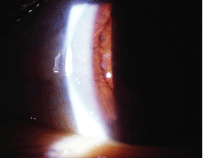 Since its introduction to clinical medicine in 2004, Avastin (bevacizumab, Genentech) has garnered tremendous attention. Within eye care, it has become widely utilized in the management of exudative and proliferative retinal disorders, including wet age-related macular degeneration, choroidal neovascularization associated with histoplasmosis and pathological myopia, proliferative diabetic retinopathy, and even retinal vein occlusions.
Since its introduction to clinical medicine in 2004, Avastin (bevacizumab, Genentech) has garnered tremendous attention. Within eye care, it has become widely utilized in the management of exudative and proliferative retinal disorders, including wet age-related macular degeneration, choroidal neovascularization associated with histoplasmosis and pathological myopia, proliferative diabetic retinopathy, and even retinal vein occlusions.
Last year, we published a column discussing the various uses of this therapeutic agent for multiple disorders of the posterior segment (see The Many Uses of Avastin, May 2008). This month, well present some interesting new applications for Avastin that involve anterior segment disease.
A VEGF Inhibitor
Avastin is a humanized monoclonal antibody that functions as a potent inhibitor of vascular endothelial growth factor (VEGF). VEGF normally interacts with receptors on the surface of endothelial cells, leading to proliferation and new blood vessel formationa process known as angiogenesis. But, Avastin binds with VEGF to prevent it from reaching these receptors, which inhibits microvascular growth.1
The drug was originally developed as an intravenous therapy for metastatic colorectal cancer; however, successful treatment of proliferative ocular disorders with similar molecules (e.g., pegaptanib and ranibizumab) prompted speculation and off-label use of Avastin for ophthalmic purposes.2 While Avastin is administered intravenously for the treatment of cancers, intravitreal injection has allowed it to be utilized in the treatment of retinal and choroidal disease.2
Avastin has shown some benefit in the treatment of neovascular glaucoma.
Avastin for Glaucoma?

Perhaps the first notable application of Avastin regarding anterior segment disease was in the realm of neovascular glaucoma. Several small case series have reported dramatic short-term improvement in patients suffering from neovascular glaucoma following intravitreal Avastin injection, with rapid regression of iris and anterior chamber angle vessels.3-6 This is remarkable because neovascular glaucoma has historically been considered a terribly recalcitrant disease, responding poorly to conventional therapy and almost inevitably resulting in profound vision loss. In virtually all of the published cases, regression of iris and angle neovascularization was visibly noticeable within days to weeks, and intraocular pressure returned to normal ranges within the same time frame.
Today, standard treatment of neovascular glaucoma involves pan-retinal photocoagulation in most cases, but the adjunctive use of intravitreal Avastin may enhance outcomes for this condition. Of course, intravitreal injections are not without risk; infectious endophthalmitis, retinal detachment and traumatic cataract are all possible complications.7 Nonetheless, the potential capacity to stabilize and even reverse the effects of iris and angle neovascularization is extremely exciting, even in light of the possible hazards.
Avastins Anterior Usage
Recently, researchers have tried Avastin on anterior ocular structures. Of particular interest is the cornea, a tissue that enjoys angiogenic privilegeit remains viable and capable of ongoing metabolism despite a lack of vascularity.
This is crucial, because blood vessels within the cornea would obviously compromise its transparency and function. Of course, a number of traumatic, infectious, inflammatory and degenerative conditions may lead to neovascularization of the cornea and subsequent impairment of vision.
One recent study proposed that anti-VEGF therapy with drugs like Avastin might limit the visual loss associated with neovascularization (conjunctivalization) of the corneal surface.8 Animal models have confirmed this hypothesis, showing dramatic results in the eyes of mice, rats, guinea pigs and rabbits with experimentally-induced corneal neovascularization.9-12 And, numerous case reports have suggested a profoundly positive impact using Avastin for corneal neovascularization in patients with a variety of disorders, including Stevens-Johnson syndrome, limbal stem cell deficiency, post-infectious keratitis, ocular cicatricial pemphigoid, interstitial keratitis, Terriens marginal degeneration, sclerokeratitis, stromal herpetic keratitis and iatrogenic disease following penetrating keratoplasty.13-17
The safety of Avastin does not appear to be an issue for the cornea, as none of these cases demonstrated any significant complications associated with anti-VEGF therapy. In addition, an in-vitro study using cultured human corneal cells (keratinocytes, fibroblasts and endothelial cells) indicated that Avastin is safe and non-toxic at the level needed to treat corneal neovascularization, which is nearly 20-fold higher than that used for intravitreal applications.18
Avastin has also been evaluated for the management of corneal neovascularization associated with recurrent pterygia. A 2008 case series of five patients concluded that, while well tolerated, the use of Avastin resulted in no significant regression of corneal vascularization, nor improvement in visual acuity.19 However, a 2009 case report showed that short-term use of topical Avastin prominently decreased limbal-conjunctival neovascularization, and the effects lasted for six months after therapy; moreover, treatment was not associated with any ocular irritation, burning, or adverse systemic effects.20
Perhaps the most intriguing aspect regarding the use of Avastin for anterior segment neovascularization is the unique routes of administration that have been employed. Subconjunctival injection (2.5mg/0.1mL) and topical eye drops (5mg to 25mg per mL) have both been used with success.13-17,19-22 Because these routes are far less invasive than intravitreal injection, the potential complications and risks are likewise greatly diminished.
While the numerous case reports described herein cannot take the place of prospective, controlled clinical trials, they are still compelling. Anti-VEGF drugs may eventually have widespread ocular applications beyond the treatment of posterior segment disease.
For optometrists, the question arises: If Avastin can be formulated into a topical delivery system, might we be able to add such a medication to our therapeutic armamentarium?
Drs. Kabat and Sowka have no direct financial interest in the products or companies mentioned in this article.
1. Genentech, Inc. Avastin package insert, February 2004.
2. Marshall J. The role of bevacizumab as first-line therapy for colon cancer. Semin Oncol 2005 Dec;32(6 Suppl 9):S43-7.
3. Kahook MY, Schuman JS, Noecker RJ. Intravitreal bevacizumab in a patient with neovascular glaucoma. Ophthalmic Surg Lasers Imag 2006 Mar-Apr;37(2):144-6.
4. Silva Paula J, Jorge R, Alves Costa R, et al. Short-term results of intravitreal bevacizumab (Avastin) on anterior segment neovascularization in neovascular glaucoma. Acta Ophthalmol Scand 2006 Aug;84(4):556-7.
5. Iliev ME, Domig D, Wolf-Schnurrbursch U, et al. Intravitreal bevacizumab (Avastin) in the treatment of neovascular glaucoma. Am J Ophthalmol 2006 Dec;142(6):1054-6.
6. Yazdani S, Hendi K, Pakravan M. Intravitreal bevacizumab (Avastin) injection for neovascular glaucoma. J Glaucoma 2007 Aug;16(5):437-9.
7. Jonas JB, Spandau UH, Schlichtenbrede F. Short-term complications of intravitreal injections of triamcinolone and bevacizumab. Eye 2008 Apr;22(4):590-1.
8. Hosseini H, Nejabat M. A potential therapeutic strategy for inhibition of corneal neovascularization with new anti-VEGF agents. Med Hypotheses 2007;68(4):799-801.
9. Bock F, Onderka J, Dietrich T, et al. Bevacizumab as a potent inhibitor of inflammatory corneal angiogenesis and lymphangiogenesis. Invest Ophthalmol Vis Sci 2007 Jun;48(6):2545-52.
10. Manzano RP, Peyman GA, Khan P, et al. Inhibition of experimental corneal neovascularisation by bevacizumab (Avastin). Br J Ophthalmol 2007 Jun;91(6):804-7.
11. Hurmeric V, Mumcuoglu T, Erdurman C, et al. Effect of subconjunctival bevacizumab (Avastin) on experimental corneal neovascularization in guinea pigs. Cornea 2008 Apr;27(3):357-62.
12. Yoeruek E, Ziemssen F, Henke-Fahle S, et al; Tbingen Bevacizumab Study Group. Safety, penetration and efficacy of topically applied bevacizumab: evaluation of eyedrops in corneal neovascularization after chemical burn. Acta Ophthalmol 2008 May;86(3):322-8.
13. Bahar I, Kaiserman I, McAllum P, et al. Subconjunctival bevacizumab injection for corneal neovascularization. Cornea 2008 Feb;27(2):142-7.
14. Qian CX, Bahar I, Levinger E, et al. Combined use of superficial keratectomy and subconjunctival bevacizumab injection for corneal neovascularization. Cornea 2008 Oct;27(9):1090-2.
15. Doctor PP, Bhat PV, Foster CS. Subconjunctival bevacizumab for corneal neovascularization. Cornea 2008 Oct;27(9):992-5.
16. Uy HS, Chan PS, Ang RE. Topical bevacizumab and ocular surface neovascularization in patients with stevens-johnson syndrome. Cornea 2008 Jan;27(1):70-3.
17. Bock F, Knig Y, Kruse F, et al. Bevacizumab (Avastin) eye drops inhibit corneal neovascularization. Graefes Arch Clin Exp Ophthalmol 2008 Feb;246(2):281-4.
18. Yoeruek E, Spitzer MS, Tatar O, et al. Safety profile of bevacizumab on cultured human corneal cells. Cornea 2007 Sep;26(8):977-82.
19. Bahar I, Kaiserman I, McAllum P, et al. Subconjunctival bevacizumab injection for corneal neovascularization in recurrent pterygium. Curr Eye Res 2008 Jan;33(1):23-8.
20. Wu PC, Kuo HK, Tai MH, Shin SJ. Topical bevacizumab eyedrops for limbal-conjunctival neovascularization in impending recurrent pterygium. Cornea 2009 Jan;28(1):103-4.
21. Awadein A. Subconjunctival bevacizumab for vascularized rejected corneal grafts. J Cataract Refract Surg 2007 Nov;33(11):1991-3.
22. DeStafeno JJ, Kim T. Topical bevacizumab therapy for corneal neovascularization. Arch Ophthalmol 2007 Jun;125(6):834-6.

